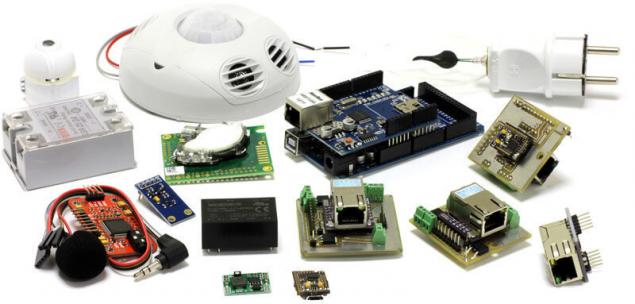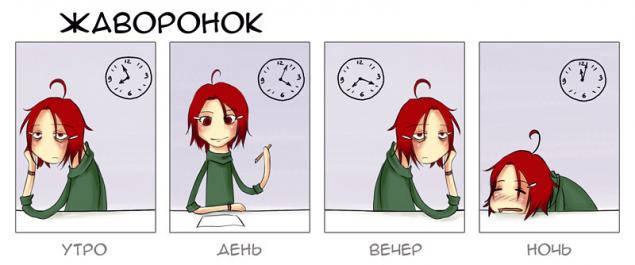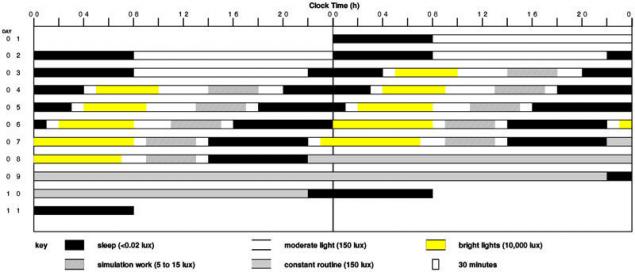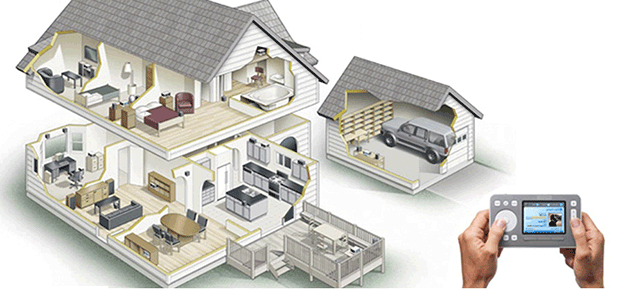Ritmanis and management of "smart house"
 Bashny.Net
Bashny.Net
House woke up an hour before the bell of your alarm clock, let the cat in the yard, then let back, comparing his face and voice sample. Turned the ventilation in the bedroom and the kitchen on the accelerated air circulation, to prepare the atmosphere for a stormy morning activities. Raised the temperature in the bedroom by two degrees to day marker to make it easier for wisesales from under the blanket. Started the heater in the bathroom to wash enough for you, wife and even for shaving. Added to the stream of intake air a light lemon flavor. Began a smooth increase of light in the bedroom.
Started in the kitchen thermo on heating water for coffee, and a slow cooker — porridge with fruit. While you selflessly fought with a cat and a wife, he watched the cat's bowl and vainly blink reminder. When the hosts filled back bowl dry food, the animal is not hungry. Turned off the thermostat, water heater and forced ventilation by opening Windows in the passive inflow valve. Lowered the room temperature to acceptable for indoor plants, watered them. Downloaded from the network to the next Chapter of a fascinating book about a smart home and plunged into reading...
All this, of course, funny and interesting, but that there is ritmanis in the header?
Ritmanis is a course in architectural science. Invented by French philosopher and sociologist Henri Lefebvre. I think he just loved to look out the window. And free from this exciting occupation is to walk and look around. And wrote a book (actually more than one) in which you taught others and told many interesting things about how the human activity affects the space. But the pulse of the city is a heavy topic, there are some rhythms with a period of tens of years for a small article that is too long. But to try to catch and “tame”, that is, to exploit the rhythms of a house is quite possible.
For starters, what are “smart home” is the point of input and output?

He gets information through sensors (light, temperature, humidity, carbon dioxide levels, sound, motion, etc., etc.), it can track the opening and closing of doors and Windows, switching on / off devices and even recognize the images from the cameras.
Respond to stimuli the house can on-off and mode change a variety of devices, opening and closing doors and Windows, alerting the owner about any events.
It is logical that the analysis and finding patterns in the incoming information flow you can configure a more suitable range of reactions. For example, energy efficiency has long been no surprise.
What rhythms can influence the life of a single household?


First, it is a daily (circadian) rhythms every inhabitant, including animals. They are a fairly complex combination (as addition to fluctuations in physics). Of course, a complete chronogram of the house to make up can't, how does he know that you are scratching the cat's belly between dinner and tea, but your regular presence in the same room is quite capable.
Weekly rhythms. If you schedule someone from the household is not 5/2, then they again formed in a fanciful pattern with the frequency already not a weekly, monthly, and even more. There will be days when all the houses when no one, when someone has one, and its sequence diagram is becoming a key for the management system.
Annual rhythms. The change of seasons, the changing length of daylight, air temperature, and so on. On the weekly and daily cycles, they also affect (like a low frequency modulation control signal of a high frequency carrier). For example, in winter you longer dressed-undressed, before you want to sleep, cook other dishes, I prefer other types of recreation, changing the ratio stay at home and on the street.
It's all theory, and how these charts can be useful in life, that they can be used to calibrate?
Yes, in General, any system of “smart home” can be adjusted using the analysis of rhythms.

For example, ventilation. If any doors in the house closed, they divide it into compartments between which the air exchange is hindered. Even if you do not have a separate station in each room, you can compute volumes, consider the point supply and exhaust, and adjust the performance of mechanical air inflow opening of the ventilation valves or air vents to maintain a comfortable atmosphere in each “compartment”. Accordingly, when all the house and all the doors are open and when someone single and all doors are closed, the ventilation will work in very different ways.
Lighting. About the opportunity to make a smooth “sunrise” blue lamp for easy spillage was already in the beginning. But the provision of indoor plants optimal length of daylight in any weather and time of year with a special lamp — it is different, you may wish to set annual and diurnal cycles and to simulate the length of day and amount of light for any latitude. Depending on the time of year, hour of day or day of the week can be calibrated and spectral characteristics of light. For example, if you work at home, you should if necessary at this time to use a cool white to avoid the body up, jerking his watch here and there. And in the evening — warm white and yellow, which are calming.

And this is picture from a study on the translation of biological clock of the human body with the help of different types of lighting. Smart home, too, so maybe if you ask nicely. For example, if you arrived from vacation with the change of time zone.
Temperature. It is worth noting that the person loses heat not only due to contact with air. Contact with objects, radiation, evaporation of moisture, contribute more. Due to this, in different seasons, the same temperature can be perceived very differently due to the different temperature of the surrounding surfaces and different clothes on the man. You can calibrate the heating and air conditioning to take into account these factors and the wishes of tenants in automatic mode without creating situations where the battery works to full capacity under an open window.
Humidity. It is associated with ventilation and heating intrinsically, but unlike them, some of her sources is dynamic: it yourself moving at home tenants, continuously midiaudio steam is sanitary areas and kitchen are used in a cyclic mode at a time and creating different vapor are the plants, the gas exchange which is subordinate to circadian rhythms. Accordingly, humidifiers also can be controlled is not random.
What is the paradigm of the smart house with rhythmanalysis different from the usual, and how to implement it?
Remember the difference between “building automation” and “smart home”: one just takes the complex includes the scripts, the other is implementing some adaptive algorithms to achieve its operating savings, safety or comfort. Ritmanis is just one of those adaptive mechanisms in the “smart home”.

At the input module has specified the “default” control scenarios “filling” of the house, tools for the collection and analysis of various statistics, including the behavior of the inhabitants and their manual intervention in their work. The output is a constant “refinement” of individual programs on selected performance criteria and a variety of combination in order to minimize the cases of manual control. For example, if the house live two people with very different ideas of bioclimatic comfort, you get a combination of routines: “only A house; warm, dark and humid”, “the house only B; cold, light and dry”, “house A and B; a few compromises depending on the weather and time of the year, no one; no minimum consumption, maximum security” and more subtle cases like “A sleeping B running, to split the house into two zones with different parameters”.
The system obviously requires training and calibration of a sufficiently long period, the usual manual control, because the annual cycle in a week will not form, and in the short term, it needed to filter out one-time fluctuations of the periodic peaks. And this is hardly a budget solution, for a given level of technological development. However, the result should be the same have been described in NF symbiotic object, by analogy with the species “homo sapiens sapiens” worthy of naming a “smart home”. Level non-adaptive “smart homes” with its disadvantages too are described in NF, for example, Bradbury in the short story “Will gentle rain”.
In General, if you spend time collecting and analyzing information, you can find a lot of interesting (but you can not find it: all people are different, and houses are different, and the concept of comfort). Just do not forget in addition to the figures to take into account their own subjective impressions and comments, because the observer is an integral tool rhythmanalysis and the main source of the actual analytical component. published
P. S. And remember, only by changing their consumption — together we change the world! ©
Source: geektimes.ru/post/277594/
Started in the kitchen thermo on heating water for coffee, and a slow cooker — porridge with fruit. While you selflessly fought with a cat and a wife, he watched the cat's bowl and vainly blink reminder. When the hosts filled back bowl dry food, the animal is not hungry. Turned off the thermostat, water heater and forced ventilation by opening Windows in the passive inflow valve. Lowered the room temperature to acceptable for indoor plants, watered them. Downloaded from the network to the next Chapter of a fascinating book about a smart home and plunged into reading...
All this, of course, funny and interesting, but that there is ritmanis in the header?
Ritmanis is a course in architectural science. Invented by French philosopher and sociologist Henri Lefebvre. I think he just loved to look out the window. And free from this exciting occupation is to walk and look around. And wrote a book (actually more than one) in which you taught others and told many interesting things about how the human activity affects the space. But the pulse of the city is a heavy topic, there are some rhythms with a period of tens of years for a small article that is too long. But to try to catch and “tame”, that is, to exploit the rhythms of a house is quite possible.
For starters, what are “smart home” is the point of input and output?

He gets information through sensors (light, temperature, humidity, carbon dioxide levels, sound, motion, etc., etc.), it can track the opening and closing of doors and Windows, switching on / off devices and even recognize the images from the cameras.
Respond to stimuli the house can on-off and mode change a variety of devices, opening and closing doors and Windows, alerting the owner about any events.
It is logical that the analysis and finding patterns in the incoming information flow you can configure a more suitable range of reactions. For example, energy efficiency has long been no surprise.
What rhythms can influence the life of a single household?


First, it is a daily (circadian) rhythms every inhabitant, including animals. They are a fairly complex combination (as addition to fluctuations in physics). Of course, a complete chronogram of the house to make up can't, how does he know that you are scratching the cat's belly between dinner and tea, but your regular presence in the same room is quite capable.
Weekly rhythms. If you schedule someone from the household is not 5/2, then they again formed in a fanciful pattern with the frequency already not a weekly, monthly, and even more. There will be days when all the houses when no one, when someone has one, and its sequence diagram is becoming a key for the management system.
Annual rhythms. The change of seasons, the changing length of daylight, air temperature, and so on. On the weekly and daily cycles, they also affect (like a low frequency modulation control signal of a high frequency carrier). For example, in winter you longer dressed-undressed, before you want to sleep, cook other dishes, I prefer other types of recreation, changing the ratio stay at home and on the street.
It's all theory, and how these charts can be useful in life, that they can be used to calibrate?
Yes, in General, any system of “smart home” can be adjusted using the analysis of rhythms.

For example, ventilation. If any doors in the house closed, they divide it into compartments between which the air exchange is hindered. Even if you do not have a separate station in each room, you can compute volumes, consider the point supply and exhaust, and adjust the performance of mechanical air inflow opening of the ventilation valves or air vents to maintain a comfortable atmosphere in each “compartment”. Accordingly, when all the house and all the doors are open and when someone single and all doors are closed, the ventilation will work in very different ways.
Lighting. About the opportunity to make a smooth “sunrise” blue lamp for easy spillage was already in the beginning. But the provision of indoor plants optimal length of daylight in any weather and time of year with a special lamp — it is different, you may wish to set annual and diurnal cycles and to simulate the length of day and amount of light for any latitude. Depending on the time of year, hour of day or day of the week can be calibrated and spectral characteristics of light. For example, if you work at home, you should if necessary at this time to use a cool white to avoid the body up, jerking his watch here and there. And in the evening — warm white and yellow, which are calming.

And this is picture from a study on the translation of biological clock of the human body with the help of different types of lighting. Smart home, too, so maybe if you ask nicely. For example, if you arrived from vacation with the change of time zone.
Temperature. It is worth noting that the person loses heat not only due to contact with air. Contact with objects, radiation, evaporation of moisture, contribute more. Due to this, in different seasons, the same temperature can be perceived very differently due to the different temperature of the surrounding surfaces and different clothes on the man. You can calibrate the heating and air conditioning to take into account these factors and the wishes of tenants in automatic mode without creating situations where the battery works to full capacity under an open window.
Humidity. It is associated with ventilation and heating intrinsically, but unlike them, some of her sources is dynamic: it yourself moving at home tenants, continuously midiaudio steam is sanitary areas and kitchen are used in a cyclic mode at a time and creating different vapor are the plants, the gas exchange which is subordinate to circadian rhythms. Accordingly, humidifiers also can be controlled is not random.
What is the paradigm of the smart house with rhythmanalysis different from the usual, and how to implement it?
Remember the difference between “building automation” and “smart home”: one just takes the complex includes the scripts, the other is implementing some adaptive algorithms to achieve its operating savings, safety or comfort. Ritmanis is just one of those adaptive mechanisms in the “smart home”.

At the input module has specified the “default” control scenarios “filling” of the house, tools for the collection and analysis of various statistics, including the behavior of the inhabitants and their manual intervention in their work. The output is a constant “refinement” of individual programs on selected performance criteria and a variety of combination in order to minimize the cases of manual control. For example, if the house live two people with very different ideas of bioclimatic comfort, you get a combination of routines: “only A house; warm, dark and humid”, “the house only B; cold, light and dry”, “house A and B; a few compromises depending on the weather and time of the year, no one; no minimum consumption, maximum security” and more subtle cases like “A sleeping B running, to split the house into two zones with different parameters”.
The system obviously requires training and calibration of a sufficiently long period, the usual manual control, because the annual cycle in a week will not form, and in the short term, it needed to filter out one-time fluctuations of the periodic peaks. And this is hardly a budget solution, for a given level of technological development. However, the result should be the same have been described in NF symbiotic object, by analogy with the species “homo sapiens sapiens” worthy of naming a “smart home”. Level non-adaptive “smart homes” with its disadvantages too are described in NF, for example, Bradbury in the short story “Will gentle rain”.
In General, if you spend time collecting and analyzing information, you can find a lot of interesting (but you can not find it: all people are different, and houses are different, and the concept of comfort). Just do not forget in addition to the figures to take into account their own subjective impressions and comments, because the observer is an integral tool rhythmanalysis and the main source of the actual analytical component. published
P. S. And remember, only by changing their consumption — together we change the world! ©
Source: geektimes.ru/post/277594/
Tags
See also
The original method of payment penalty receipts (9 photos)
What kind of legitimacy of such power may be involved?
Smart home – universal automation
Smart house: Development and trends
Smart home: what components to buy
Smart home office - MIT's version of the 1977
System "clever house" allows to save the residents of the village in Yakutia
Smart home in the US Honda is ready for testing
Scientists from the US are taught at home to talk to the power grids
















